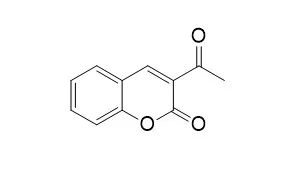| In vitro: |
| Chinese Journal of Pesticide ence, 2016. | | Study on acaricidal bioactivity and quantitative structure activity relationship of coumarin compounds against Tetranychus cinnabarinus Bois.(Acari: Tetranychidae).[Reference: WebLink] |
METHODS AND RESULTS:
The acaricidal bioactivities of 25 representative coumarin compounds were evaluated by slide-dip method and a quantitative structure-activity relationship(QSAR) model with strong predictive ability was established. The acaricidal assay results showed that all the tested compounds exhibited high contact activity against Tetranychus cinnabarinus and the contact activity increased with prolongation of treatment time. The 48 h LC_(50) values of 8 compounds [3-(2-benzimidazolyl)-7-(diethylamino)coumarin(1), 3-(2- benzothiazolyl)-7-(diethylamino)coumarin(2), 3-aminocoumarin(3), 3-Acetylcoumarin(4), 4- methoxycoumarin(5), 6-nitrocoumarin(8), 6,7-dimethoxy coumarin(13), 7,8-dihydroxy- coumarin(21)] were less than 1 000 mg/L. The acaricidal activities of compouds 1, 2, 3, 5and 13 were higher or comparable to 98.32% spirodiclofen TC. The 48 h and 72 h LC_(50) values of the compound with the highest acaricidal activity(13) were 284.8 and 122.2 mg/m L respectively. The acaricidal activity against T. cinnabarinus of compound 13 was two fold higher than that of spirodiclofen. 34 physicochemical parameters of the above mentioned 25 coumarin compounds were calculated and used to build a QSAR model. SPSS Stepwise Regression analysis method was applied,without correlation and correcting.
CONCLUSIONS:
And the Stretch-Bend Dipole, Dipole, Total Energy and Molecular Radius were taken as independent variables in the model. This model has a strong predictive ability with R = 0.987, R2 = 0.967 and F = 155.176. |
|






 Cell. 2018 Jan 11;172(1-2):249-261.e12. doi: 10.1016/j.cell.2017.12.019.IF=36.216(2019)
Cell. 2018 Jan 11;172(1-2):249-261.e12. doi: 10.1016/j.cell.2017.12.019.IF=36.216(2019) Cell Metab. 2020 Mar 3;31(3):534-548.e5. doi: 10.1016/j.cmet.2020.01.002.IF=22.415(2019)
Cell Metab. 2020 Mar 3;31(3):534-548.e5. doi: 10.1016/j.cmet.2020.01.002.IF=22.415(2019) Mol Cell. 2017 Nov 16;68(4):673-685.e6. doi: 10.1016/j.molcel.2017.10.022.IF=14.548(2019)
Mol Cell. 2017 Nov 16;68(4):673-685.e6. doi: 10.1016/j.molcel.2017.10.022.IF=14.548(2019)